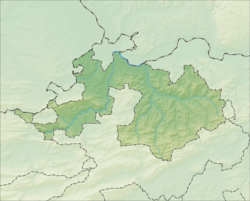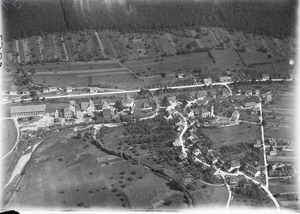Zwingen facts for kids
Quick facts for kids
Zwingen
|
||
|---|---|---|
 |
||
|
||
| Country | Switzerland | |
| Canton | Basel-Landschaft | |
| District | Laufen | |
| Area | ||
| • Total | 4.61 km2 (1.78 sq mi) | |
| Elevation | 341 m (1,119 ft) | |
| Population
(Jun 2021 )
|
||
| • Total | 2,563 | |
| • Density | 556.0/km2 (1,439.9/sq mi) | |
| Postal code |
4222
|
|
| Surrounded by | Blauen, Brislach, Dittingen, Laufen, Nenzlingen | |
Zwingen is a municipality (a type of town or local area) in the Laufen district. It is located in the canton of Basel-Country in Switzerland.
Contents
What is Zwingen Like?
Zwingen covers an area of about 4.62 square kilometers (about 1.78 square miles). A big part of this land, about 33%, is used for farming. This includes fields for crops and areas for animals to graze.
Another large part, about 38%, is covered by forests. These are important for nature and provide green spaces. About 25% of Zwingen's land is developed with buildings and roads. A small amount, about 2.6%, is made up of rivers and lakes.
How Zwingen's Land is Used
- Buildings and Roads: About 25% of the land has buildings or roads. This includes places for factories (4.8%), homes (6.9%), and transportation like roads (8.9%). There are also areas for power and water (3.0%) and parks (1.9%).
- Forests: Most of the forest land (34.6% of Zwingen's total area) is dense forest. A smaller part (3.5%) has orchards or small groups of trees.
- Farming: About 19.9% of the land is used for growing crops. Another 12.8% is used as pastures for animals. All the water in Zwingen is flowing water, like rivers.
Zwingen's Coat of Arms
The coat of arms for Zwingen is black. It shows two silver sticks that look like they have flowers on the ends. They are crossed over each other, like an "X". This design is unique to Zwingen.
Who Lives in Zwingen?
Zwingen has a population of about 2,000 people. A small part of the population, around 15.6%, are people from other countries. Over the past ten years, the number of people living in Zwingen has grown by about 9.3%.
Languages Spoken
Most people in Zwingen speak German. About 88% of the population uses German as their main language. Other languages spoken include Italian language (about 2.1%) and Turkish (about 2.0%). A few people also speak French.
Where People Come From
Many people living in Zwingen were born there (about 29.5%). Others were born in the same canton (about 21.2%) or elsewhere in Switzerland (about 29.3%). About 16.4% of the people in Zwingen were born outside of Switzerland.
Age Groups in Zwingen
In Zwingen, the population includes:
- Children (0-6 years): About 6%
- Teenagers (7-19 years): About 16.2%
- Young Adults (20-29 years): About 12.9%
- Adults (30-49 years): About 33.2%
- Older Adults (50-64 years): About 19%
- Seniors (65+ years): About 12.7%
Homes and Households
In Zwingen, there are about 826 private households. On average, about 2.4 people live in each home. About 26.5% of homes are lived in by just one person. There are also many married couples, some with children and some without.
Most of the homes in Zwingen are single-family houses (about 61.7%). There are also multi-family buildings with several apartments. Many new homes were built between 1990 and 2000.
Apartments in Zwingen
There are about 892 apartments in Zwingen. The most common size is a 4-room apartment. Most apartments (about 90.7%) are lived in all the time. A small number are used seasonally or are empty.
The chart below shows how Zwingen's population has changed over time:

Important Places to See
The entire village of Zwingen is considered a special place. It is part of the Inventory of Swiss Heritage Sites. This means it has important historical or cultural value.
How People Work in Zwingen
Zwingen has many different types of jobs. In 2005, about 28 people worked in farming. This is called the primary economic sector.
Many more people work in the secondary sector. This includes jobs in manufacturing (making things) and construction (building things). About 365 people worked in this sector.
The largest number of jobs are in the tertiary sector. This includes jobs that provide services. About 482 people worked in this sector. These jobs include:
- Sales: Many people work in shops or selling cars.
- Transport: Some work in moving goods or people.
- Hotels and Restaurants: A few work in places where people stay or eat.
- Specialized Jobs: This includes scientists, teachers, and people in healthcare.
Commuting to Work
Many people who live in Zwingen travel to other towns for work. Also, many people from other places come to Zwingen to work. About 12.7% of the people who come to work in Zwingen are from outside Switzerland.
Most people get to work by private car (about 51.7%). About 18.9% use public transportation, like trains or buses.
Beliefs and Religions
In Zwingen, people follow different religions.
- Roman Catholic: About 57.6% of the population are Roman Catholic.
- Swiss Reformed Church: About 14.9% belong to the Swiss Reformed Church.
- Other Christian Churches: A small number belong to Orthodox churches or other Christian groups.
- Islam: About 5.55% of the population are Islamic.
- Other Religions: There are also people who are Buddhist or Hindu.
- No Religion: About 13.09% of the population do not belong to any church.
Getting Around Zwingen
Zwingen is located on the Basel–Biel/Bienne railway line. This means it has a train station called Zwingen railway station. Local trains stop here, making it easy for people to travel to and from Zwingen.
Learning and Education
Many people in Zwingen have completed a good level of education. About 41.2% of the population have finished upper secondary education. This is like high school.
About 8.9% of people have gone on to higher education. This means they have studied at a university or a specialized college. Many students from Zwingen also attend schools in other towns.
See also
 In Spanish: Zwingen para niños
In Spanish: Zwingen para niños





